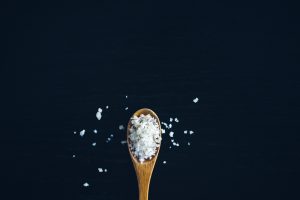 People overweight and those with high blood pressure are often given a diet without salt. Studies all agree that the average American diet is contains too much sodium. The chemical name for salt is sodium chloride, and it’s one of the leading causes of too much sodium that can lead to stroke and heart disease. While most people think that adding salt is the problem, the real problem comes from packaged food and those that are ready to heat and serve. That’s why reading the label is important. However, you need some sodium intake and too little can also cause problems.
People overweight and those with high blood pressure are often given a diet without salt. Studies all agree that the average American diet is contains too much sodium. The chemical name for salt is sodium chloride, and it’s one of the leading causes of too much sodium that can lead to stroke and heart disease. While most people think that adding salt is the problem, the real problem comes from packaged food and those that are ready to heat and serve. That’s why reading the label is important. However, you need some sodium intake and too little can also cause problems.
What sodium does to your body.
You need some sodium to maintain nerve and muscle function and to maintain and adequate amount of water in and around the cells. Too much, however, is unhealthy. It pulls water into the blood stream, attracting it and increasing not only blood volume, but also blood pressure. That makes the heart work hard, forcing blood through arteries and ultimately damaging them and organs. Increasing blood pressure can occur naturally as people age, so lowering the sodium intake is even more important as you get older.
A low or no salt diet is one way to lower your sodium intake.
Besides hiding the salt shaker when you cook or you eat, there are other things you can do to lower your sodium intake. Read labels to find out how much sodium food contains. Eat more whole foods and fewer prepared ones. Herbs and spices can add more flavor than the salt shaker ever did, consider those as alternatives. You can rinse off the liquid of beans and other vegetables to lower their sodium count.
You need some salt in your diet.
Studies show that a low or no salt diet might actually exacerbate the potential for heart attack or stroke. It also can increase the risk of insulin resistance that leads to diabetes and raise bad cholesterol levels. A few studies show that it can increase the risk of death in both type 1 and 2 diabetics. So what’s the answer? Rather than a no salt diet, one with a moderate intake is better. Limiting your sodium intake to about a teaspoon a day, or 2300 milligrams is about right, but always consult your health care professional.
- You’ll probably lose weight on a low salt or sodium diet. That’s because many pastries, high calorie foods and processed foods are high in sodium, lowering your caloric intake.
- Be aware that salad dressing and ketchup also contain high amounts of sodium. If you eat in restaurants, opt for vinegar and oil.
- 400 milligrams of sodium are in one gram of salt. Adults require approximately 2300 milligrams of sodium, so about six grams of salt.
- Just one hamburger or a slice of pizza can contain approximately 1500 milligrams of salt. Foods that contain the most sodium include frozen burritos, pizza, salted nuts, canned main dishes like ravioli and canned beans with salt added.
For more information, contact us today at Next Level Fitness
